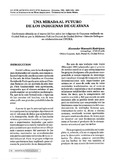| dc.rights.license | http://creativecommons.org/licenses/by-nc-sa/3.0/ve/ | es_VE |
| dc.contributor.author | Mansutti Rodríguez, Alexander | |
| dc.date.accessioned | 2022-06-10T13:48:29Z | |
| dc.date.available | 2022-06-10T13:48:29Z | |
| dc.date.issued | 2022-06-10 | |
| dc.identifier.issn | 1325-2610 | es |
| dc.identifier.uri | http://www.saber.ula.ve/handle/123456789/48152 | |
| dc.description.abstract | El autor intenta hacer algunas proyecciones de las tendencias que hoy aparecen como evidentes en los indígenas de Venezuela, con la conciencia de las limitaciones de tales proyecciones, pues no se cuenta aún con la materia prima básica que permita establecer escenarios globales posibles con rangos de error aceptables. Por esto sólo se proponen hacer aquí predicciones mínimamente confiables, refiriéndose no a la configuración total de las futuras sociedades indígenas sino a algunos de sus elementos más destacados, procurando evitar emitir juicios de valor sobre las proyecciones, por corresponder este rola los propios indígenas. Empieza por la dinámica que ha caracterizado a éstos desde la llegada del español, para ocuparse de los actuales hiwi (Guahibos), Ye' Kwana, Piaroa, etc. Y llegar a la conclusión que la perspectiva desarrollada excluye ya toda posibilidad de desaparición, y que los indígenas lograrán su base territorial, con integración lenta a la sociedad global | es_VE |
| dc.language.iso | es | es_VE |
| dc.rights | info:eu-repo/semantics/openAccess | es_VE |
| dc.subject | Proyecciones | es_VE |
| dc.subject | Futuro Indígena | es_VE |
| dc.subject | Venezuela | es_VE |
| dc.title | Una mirada al futuro de los indígenas de Guayana | es_VE |
| dc.title.alternative | A look at the future of the indigenous people of Guyana | es_VE |
| dc.type | info:eu-repo/semantics/article | es_VE |
| dc.description.abstract1 | The author attempts to make some projections from apparently clear tendencies in present day Venezuela indigenous peoples; he is aware of the limitations of these projections, since the basic material wich would allow possible global scenarios with acceptable ranges of error to be established is not available. He thus aims to make only to the general configuration of future indigenous societies but to some of their most outstanding aspects, and avoiding value judgments with regard to te projections (since this role should be played by the indigenous peoples themselves). He begins with the dynamics of their survival since the arrival of the Spanish, and goes on to concern himself with the present-day Hiwi (Guahibos), Ye' Kwana, Piaroa, etc; he concludes that according to this perspective there exist no possibility of the disappearance of the indigenous peoples since they will succeed in ensuring their territorial base and slowly integrate into society in general | es_VE |
| dc.description.colacion | 16-32 | es_VE |
| dc.description.dependencia | Museo Arqueológico “Gonzalo Rincón Gutiérrez” | es |
| dc.description.email | pupeto47@gmail.com | es_VE |
| dc.description.frecuencia | Cuatrimestral | es |
| dc.description.paginaweb | www.saber.ula.ve/boletin_antropologico | es |
| dc.identifier.depositolegal | P.P 82-0186 | es |
| dc.publisher.pais | Venezuela | es_VE |
| dc.subject.institucion | Universidad de Los Andes | es_VE |
| dc.subject.keywords | Projections | es_VE |
| dc.subject.keywords | Future of Indigenous Peoples | es_VE |
| dc.subject.keywords | Venezuela | es_VE |
| dc.subject.seccion | Boletín Antropológico: Articulo | es_VE |
| dc.subject.tipo | Revistas | es_VE |
| dc.type.media | Texto | es_VE |


